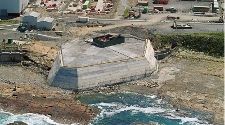
At the recent ICEM05 conference, James Penfold presented a paper on the preliminary post-closure safety case for the Dounreay shaft.
The D1225 Shaft at Dounreay was authorised for the disposal of low and intermediate level radioactive waste in 1958. It lies close to sea cliffs on the north-western edge of the site and is 65 m deep, with a diameter of 4.6 m. Over 800 m³ of waste was disposed to the Shaft, the majority during the 1960s. All disposals ceased in 1977 following a hydrogen gas explosion that occurred in the headspace above the waste. The facility has since been maintained in a state of Care and Maintenance.
UKAEA has concluded that the retrieval of the waste is required to ensure that the Shaft can be closed safely, and detailed technical studies have investigated how this can be achieved. These studies identified that the Shaft needs to be hydraulically isolated from the surrounding rock and that a concrete plug at the base of the facility should be reinforced. A systematic examination and appraisal of the relevant technical options identified a preferred method for hydraulic isolation and plug reinforcement, based on the use of rock grouting.
Before commencing with detailed design and implementation of grouting works, UKAEA has undertaken a comprehensive analysis of the safety of the closed Shaft, which has resulted in the production of a Preliminary Post-Closure Safety Case (Preliminary PCSC). The main objective of the Preliminary PCSC is to provide robust arguments that the residual contamination around the Shaft will not result in unacceptable effects on human health and the environment, and thereby permit the next phase of closure activities to proceed. Regulatory guidance defines the information that is expected in a PCSC; however, this is primarily for use in the authorisation of new disposal facilities. Nevertheless, the Preliminary PCSC for the Shaft comprises a suite documents addressing the requirements of this guidance.
The Main PCSC Report describes twenty key factors that constitute UKAEA's safety case for the closed Shaft. These safety factors are based on the scientific and technical understanding of the system and draw on a supporting performance assessment study. They are both qualitative and quantitative, and are diverse in nature. Together, they provide 'multiple lines of reasoning' that support the case for post-closure safety.
The Main Report is supported by six other reports. Three describe what is known about the radioactive contamination around the Shaft, and the characteristics of the facility and its environment. A detailed performance assessment of long-term safety is reported, using modelling tools founded on this information. The options for the closure state of the Shaft are also examined in a supporting report, and a further document describes how the closure of the Shaft will be managed.
The Preliminary PCSC has been submitted to the regulatory authorities for review, and is also undergoing independent peer review. Periodic revisions to the PCSC will be driven by regulatory milestones, the availability of new information and other external changes, such as national policy developments.
Image Courtesy of Dounreay Restoration Site Limited.
James Penfold, Warren Jones and Michael Tait. Preliminary Post-Closure Safety Case for the Dounreay Shaft. ICEM'05: The 10ᵗʰ International Conference on Environmental Remediation and Radioactive Waste Management September 4-8, 2005, Scottish Exhibition & Conference Centre, Glasgow, Scotland